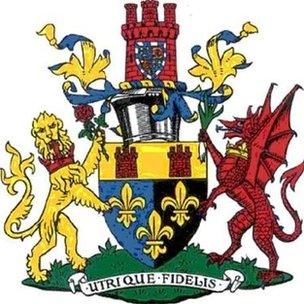The Monmouthshire myth
- Cyhoeddwyd

Wales and England - separated by the River Wye
Professor Chris Williams, head of the School of History, Archaeology and Religion at Cardiff University, detangles the shifting history and nationality of his native Monmouthshire, host county of this year's National Eisteddfod.

This year the National Eisteddfod takes place in Abergavenny. It's not the first time it's been held in the town - it was there in 1913 - but it is the first time it's been held in Monmouthshire.
Confused? Well, you're not alone. 'Monmouthshire' today of course is not the Monmouthshire of old. The unitary authority of Monmouthshire was created in 1996 when Gwent was broken up during the reorganisation of local government.
Gwent had only came into existence in 1974, replacing the historic county of Monmouthshire. That was created when the sixteenth-century Acts of Union brought Wales and the Marches into the English state. That older version of Monmouthshire was formed from the existing Welsh kingdoms of Glywysing and - yes - Gwent.
Shifting history
Quite apart from the potential for terminological muddles, this shifting history has also sometimes made it difficult to know whether this particular corner of Wales was actually in Wales at all.
The trouble began with the Acts of Union, which rendered the border between Wales and England almost irrelevant. Monmouthshire was brought under English forms of legal jurisdiction and given two MPs (the English model) rather than one, as was the case in the rest of Wales.
From that point on until the Local Government Act of 1972 which created the unambiguously Welsh county of Gwent, Monmouthshire's national status was a matter of dispute. The official line, upheld by legal opinion, was that it was part of England, but could be 'linked to Wales for administrative purposes'.
Monmouthshire was included in the 1889 Intermediate and Technical Education (Wales) Act, but was not in the Sunday Closing (Wales) Act of 1881. Disestablishment came into force in Monmouthshire as in the rest of Wales in 1920, but when in 1937 it was proposed to extend the boundaries of Cardiff east of the river Rhymni objections were raised on the grounds that this would infringe the border between England and Wales!
'Faithful to both'

A lion and a dragon were featured on the old Monmouthshire County Council coat of arms
Conscious of its uncertain position, when Monmouthshire County Council obtained a coat of arms in 1948, it featured both a rose-wielding English lion and a leek-brandishing Welsh dragon, and its motto 'Utrique Fidelis' meant 'faithful to both'.
Law was one thing, popular opinion another. Despite the decline of the Welsh language in Monmouthshire in the nineteenth century, other social and economic trends tended to reinforce the county's 'Welshness'.
The development of heavy industry connected it forcefully to its Glamorgan neighbours and the Welsh rugby team played some home internationals at Rodney Parade, Newport. Newport RFC was affiliated to both the English RFU and the Welsh Rugby Union, but the majority of its internationals appeared in the red shirts of Wales.
1897 saw the first National Eisteddfod held in the county - also in Newport - hailed by the South Wales Argus as 'an act of repatriation', even if Newportonian dialect rendered the event as the 'Stedvurd'! Since 1897 the Eisteddfod has visited the area six times (Abergavenny, Pontypool, Newport and Ebbw Vale twice each).
'Mongrel place with mongrel place names'
Not everyone has been comfortable with the trend. In the 1960s the Royal Society of St George jostled with the 'Monmouthshire is Welsh' society for attention, and occasionally the 'Welcome to Wales' signs that began to be erected inside the county's eastern borders were defaced. Suggestions were made that the county be split in half and divided between Wales and England, or even that it be made independent - a kind of 'buffer state' between the two.
Others celebrated this 'mongrel place with mongrel place names'. The writer Raymond Williams who grew up in Pandy, north of Abergavenny, stated as late as 1987 that local residents 'talk about both the English and Welsh as other peoples'.
The argument was settled legally by local government reorganisation in 1970s. Residents of the area were as entitled as anyone else in Wales to vote in the 1979 devolution referendum (like most, they voted 'No') and since 1999 the area has been subject to devolved government.
And while it's impossible to predict the future with confidence, there appears to be little appetite in modern Monmouthshire for what might be called 'Gwexit'. Be grateful for small mercies!